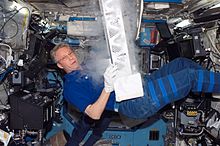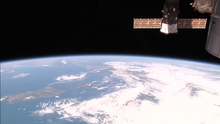Research on the ISS

The research on the ISS offers several conditions unattainable on earth thanks to the international space station ISS . Devices for astronomical and meteorological investigations can easily be attached outside the ISS and physical and biological samples can be exposed to space conditions for a longer period of time. The experiments inside the ISS mainly use permanent microgravity . In addition, the astronauts themselves also serve as test subjects for studies in (space) medicine, in which mission-related stress also plays a role.
So far around 50 experiments with German participation have been started and partially completed, which is why a few typical examples are selected below.
The ISS as a platform in space
Experimental platforms can be installed outside the ISS in order to expose materials and biological samples to long-term space conditions, including vacuum, increased UV radiation, cosmic radiation and extreme temperature differences. Examples are the European Technology Exposure Facility (EuTEF) and ROKVISS . ROKVISS is the prototype of a robotic arm for future satellite maintenance missions .
astronomy
Astronomical observation devices are or will be attached to the ISS, which means that they do not need their own power supply and position control. The Alpha Magnetic Spectrometer (AMS) is dedicated to investigating cosmic radiation and the Solar Monitoring Observatory (SOLAR) is dedicated to the fluctuations in solar radiation, which also influence the climate.
Physics and materials research
In microgravity, atomic particles can be kept longer in an observable volume, which enables more accurate atomic clocks . Since the ISS is less attracted to the earth and moves faster than terrestrial atomic clocks, more precise examinations of the general and the special theory of relativity are possible. This is the goal of the Atomic Clock Ensemble in Space (ACES) .
The Materials Science Laboratory (MSL) is used to melt and solidify conductive metals , alloys and semiconductors in extreme vacuum or in high-purity noble gas environments in microgravity. Among other things, diffusion processes can be investigated, which are superimposed on earth by convection .
The electromagnetic levitator (EML) can be used to keep molten metal in suspension so that it does not come into contact with the vessel walls.
Essential experiments for researching plasma crystals were and will be carried out on the ISS.
Biology and biotechnology
Protein crystals are easier to grow under microgravity conditions. Accordingly, various such experiments have been and are being carried out on the ISS. You need proteins in crystal form every time the protein structure is to be determined, usually with X-ray structure analysis . Without knowing the structure of a protein, drugs cannot be developed that affect the protein or enzyme.
Human medicine
During longer stays in a microgravity environment, muscle and bone loss occurs due to the lack of stress. Corresponding studies on the ISS serve, on the one hand, for basic research into relevant diseases ( e.g. osteoporosis ), but also to find countermeasures for longer manned space flights (e.g. to Mars).
The blood circulation and the immune system also behave differently in space than on Earth, whereby mission-related stress due to spatial confinement, high workload and abnormal day-night rhythm also plays a role in the latter.
Telemedicine methods are also being tested on the ISS, for example in the Advanced Diagnostic Ultrasound in Microgravity (ADUM) experiment .
Earth observation

The ISS is also used for remote sensing and GIS . This area of research is managed by the Image Science and Analysis Laboratory in NASA-Johnson Space Center . The laboratory maintains The Gateway to Astronaut Photography of Earth .
In April 2014, four commercial off-the-shelf cameras were attached by a robotic arm to the European Columbus laboratory as part of the High Definition Earth Viewing (HDEV) mission . The HD cameras observe the earth from three different angles and broadcast live videos. In cooperation with DLR and NASA , the University of Bonn makes the videos and images from the HDEV cameras available to the public on the "Columbus Eye" web portal. The project will also accompany the space flight of the German astronaut Alexander Gerst to the ISS.
Photos taken by astronauts on the ISS serve as a supplement to those taken by earth observation satellites, as the angle of view is not fixed.
flora
At the beginning of 2016, this flowering plant was first grown on the ISS with an orange-yellow zinnia. The Soviet Union achieved a similar achievement on the Salyut 7 space station in 1982, on the STS-51 mission and on the ISS in 2012.
Others
Research on the ISS also includes tests of commercial products, which, however, are primarily used for product placement , as well as experiments in the context of public relations (e.g. SuitSat ). Of around 270 scientific cargoes that the ISS National Lab (a NASA laboratory) sent to the ISS through the Center for the Advancement of Science in Space , a total of 176 were commercial cargoes by October 2018.
See also: Biolab , Materials International Space Station Experiment
See also
Individual evidence
- ↑ Various authors: Spectrum of Science EXTRA: Weightless - Europe researches in space . Ed .: Spektrum custom publishing, Space Channel, German Aerospace Center. Spectrum custom publishing, 2010, ISBN 978-3-941205-48-2 , p. 19 .
- ↑ Stars and Space 12/2006; ISSN 0039-1263 ; Page 46 ff.
- ↑ ROKVISS. Institute for Robotics and Mechatronics at DLR , accessed on July 9, 2020 .
- ↑ Natalie Krivova: Solar Variability and Climate: Does the Sun affect the Earth's climate? Max Planck Institute for Solar System Research , October 28, 2003, archived from the original on April 6, 2013 ; Retrieved March 26, 2013 .
- ↑ Various authors: Spectrum of Science EXTRA: Weightless - Europe researches in space . Ed .: Spektrum custom publishing, Space Channel, German Aerospace Center. Spectrum custom publishing, 2010, ISBN 978-3-941205-48-2 , p. 94 f .
- ↑ Michael Schumacher: Space biology research: instruments for space biology research. raumfahrer.net, August 23, 2003, accessed March 26, 2013 .
- ↑ Various authors: Spectrum of Science EXTRA: Weightless - Europe researches in space . Ed .: Spektrum custom publishing, Space Channel, German Aerospace Center. Spectrum custom publishing, 2010, ISBN 978-3-941205-48-2 .
- ^ Ultrasound from a Distance. NASA , December 18, 2009, accessed March 26, 2013 .
- ↑ Rienow, A .; Hodam, H. & Menz, G. (2014): Columbus Eye - HD - Earth observation from the ISS. In: Joint conference 2014 of the DGfK, the DGPF, the GfGI and the GiN (DGPF conference proceedings 23/2014), Article 112. ( Memento from May 28, 2014 in the Internet Archive )
- ^ Earth Observation Photography. (PDF; 783 kB) January 8, 2009, archived from the original on July 10, 2003 ; accessed on March 26, 2013 (English).
- ^ Image Science and Analysis Laboratory: The Gateway to Astronaut Photography of Earth. Lyndon B. Johnson Space Center , archived from the original on October 29, 2011 ; accessed on March 26, 2013 (English).
- ↑ Kristina Beer: US astronaut: First "space flower" blooms on the ISS space station. In: Heise online . January 18, 2016, accessed January 18, 2016 .
- ^ First species of plant to flower in space. Guinness World Records, accessed January 18, 2016 .
- ↑ Keith Cowing: No NASA, These Are Not The First Plants To Flower In Space. NASA Watch, January 16, 2016, accessed January 18, 2016 .
- ↑ Don Pettit: Letters to Earth: Astronaut Don Pettit (June 17-26 - Diary of a Space Zucchini). NASA, accessed June 29, 2012 .
- ^ Jackie Wattles: Why Goodyear and Delta Faucet are doing research in space. August 5, 2018, accessed July 12, 2020 .
Web links
- NASA experiment list
- Experiment lists on raumfahrer.net:
- Biotechnological research: More information on an ISS experiment. August 23, 2003, accessed March 26, 2013 .
- Physical sciences: More information on instruments used in physical sciences. August 23, 2003, accessed March 26, 2013 .
- Space biology research: instruments for space biology research. August 23, 2003, accessed March 26, 2013 .
- Geophysics research: More information about instruments used in geophysics research. August 23, 2003, accessed March 26, 2013 .
- Technical research: instruments for technical research. August 23, 2003, accessed March 26, 2013 .
- Michaela Wailzer: Space advertising: Saxons shoot cheese into space. Spiegel Online , April 23, 2003, accessed March 26, 2013 .
- Tim Pritlove: Space-time podcast by ESA and DLR about research on the ISS. German Aerospace Center , September 20, 2013, accessed on January 5, 2014 .
- University of Bonn: Columbus Eye - Live images from the ISS in school lessons. German Aerospace Center , May 26, 2014, accessed on May 26, 2014 .
- The Gateway to Astronaut Photography of Earth

